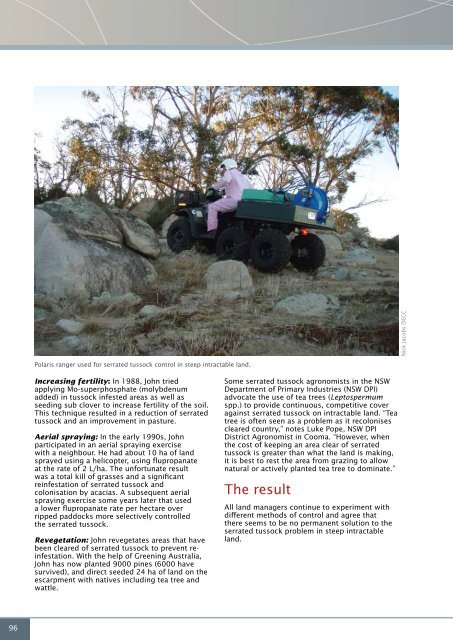Section 5 Case studies - Weeds Australia
Section 5 Case studies - Weeds Australia
Section 5 Case studies - Weeds Australia
You also want an ePaper? Increase the reach of your titles
YUMPU automatically turns print PDFs into web optimized ePapers that Google loves.
Nick Jacobs DECC<br />
Polaris ranger used for serrated tussock control in steep intractable land.<br />
Increasing fertility: In 1988, John tried<br />
applying Mo-superphosphate (molybdenum<br />
added) in tussock infested areas as well as<br />
seeding sub clover to increase fertility of the soil.<br />
This technique resulted in a reduction of serrated<br />
tussock and an improvement in pasture.<br />
Aerial spraying: In the early 1990s, John<br />
participated in an aerial spraying exercise<br />
with a neighbour. He had about 10 ha of land<br />
sprayed using a helicopter, using flupropanate<br />
at the rate of 2 L/ha. The unfortunate result<br />
was a total kill of grasses and a significant<br />
reinfestation of serrated tussock and<br />
colonisation by acacias. A subsequent aerial<br />
spraying exercise some years later that used<br />
a lower flupropanate rate per hectare over<br />
ripped paddocks more selectively controlled<br />
the serrated tussock.<br />
Revegetation: John revegetates areas that have<br />
been cleared of serrated tussock to prevent reinfestation.<br />
With the help of Greening <strong>Australia</strong>,<br />
John has now planted 9000 pines (6000 have<br />
survived), and direct seeded 24 ha of land on the<br />
escarpment with natives including tea tree and<br />
wattle.<br />
Some serrated tussock agronomists in the NSW<br />
Department of Primary Industries (NSW DPI)<br />
advocate the use of tea trees (Leptospermum<br />
spp.) to provide continuous, competitive cover<br />
against serrated tussock on intractable land. “Tea<br />
tree is often seen as a problem as it recolonises<br />
cleared country,” notes Luke Pope, NSW DPI<br />
District Agronomist in Cooma. “However, when<br />
the cost of keeping an area clear of serrated<br />
tussock is greater than what the land is making,<br />
it is best to rest the area from grazing to allow<br />
natural or actively planted tea tree to dominate.”<br />
The result<br />
All land managers continue to experiment with<br />
different methods of control and agree that<br />
there seems to be no permanent solution to the<br />
serrated tussock problem in steep intractable<br />
land.<br />
96

















